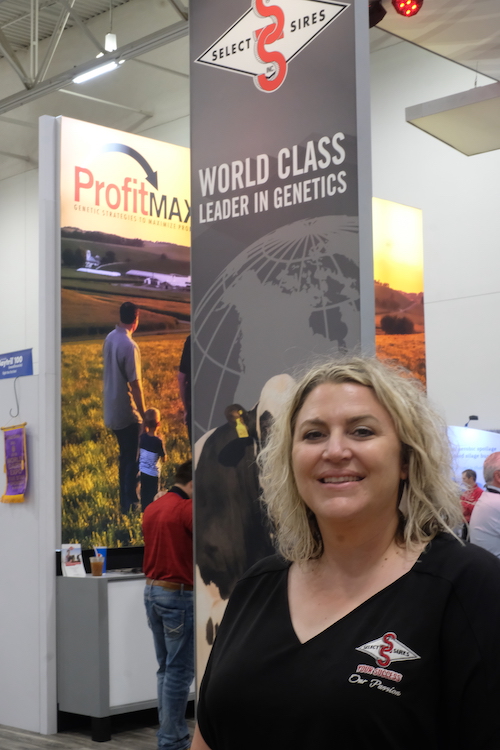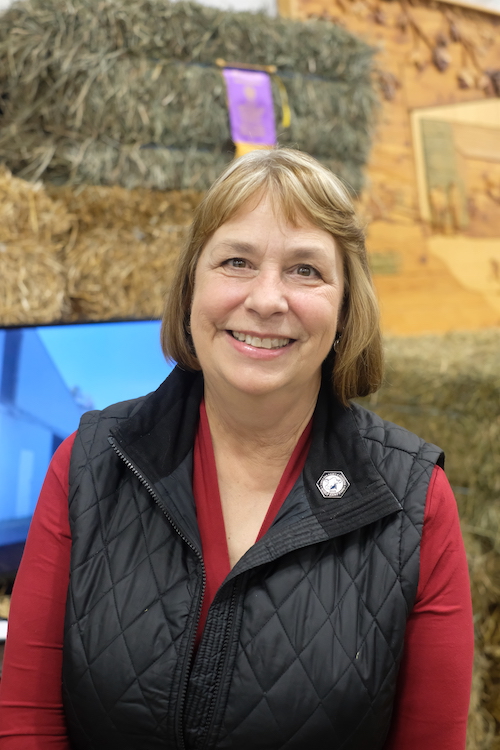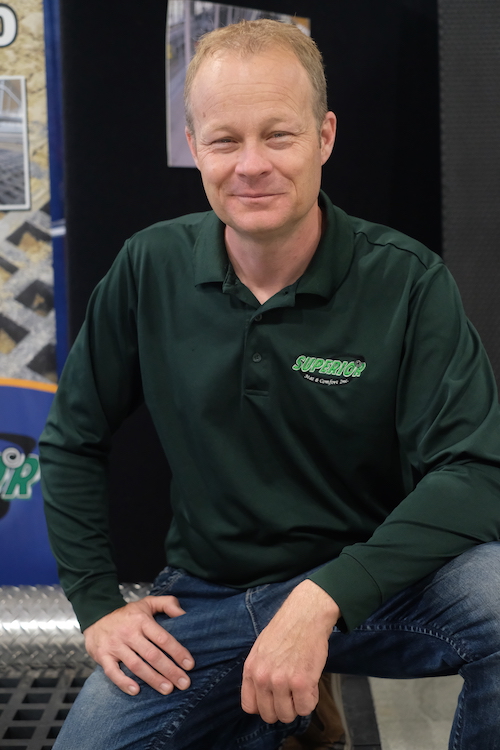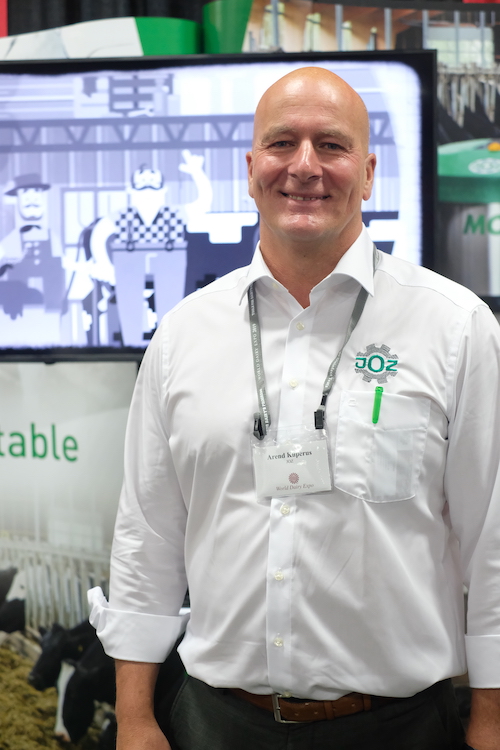World Dairy Expo: The Place to Be

Unparalleled. Using the word to describe the Trade Show at World Dairy Expo (WDE) is to engage in a bit of understatement.
What else can you say about a five-day event that last year featured more than 850 exhibitors from 30 countries, all promoting the latest and greatest in products and services geared to making dairy producers more efficient and profitable. Included in the total for 2019 were 97 first-time WDE exhibitors. “The Trade Show features the breath of the industry, including large and small companies, companies that have exhibited at all 53 World Dairy Expos (dating back to 1967) and companies that are brand new to the industry,” says WDE Trade Show manager Crystal Ripp. “Whatever your interests--- conventional or organic farming, dairy cows or dairy goats, grazing or free stalls---there truly is something for everyone at World Dairy Expo.”
For companies exhibiting in the Trade Show, the fact that Expo draws more than 60,000 attendees annually is a major benefit. “Those 60,000 people are representatives from around the world who are making buying decisions, as well as industry influencers like nutritionists, veterinarians and consultants who are learning new information to take back to the herds they serve,” says Ripp. “There are also incredible networking opportunities at Expo with dairy producers, government personnel, university researchers and industry experts and CEOs interacting throughout the event.”
The dairy-specific nature of the show is another drawing card for companies. “Focusing exclusively on the dairy industry in the Trade Show has been a major part of our strategy from the start,” says Ripp. “This laser focus helps both exhibiting companies and attendees know that what they find here will be relevant to their businesses and interests.”
Select Sires, Inc. is in a unique position to evaluate the value of participating in the WDE Trade Show. The farmer-owned and controlled cooperative, which markets dairy and beef semen along with services and programs related to genetics, through six member cooperatives in the U.S. was one of the original Trade Show exhibitors when WDE came into being more than 50 years ago. “Our leadership at that time had the foresight to see how important having an event like this would be,” says Leslie Maurice, director of communications at Select Sires. “It gives the entire industry a place to meet and do business every year.”
Select Sires’ original booth was in the Coliseum. where it’s still located today. In 1996, the cooperative added another booth in the Exhibit Hall to its’ WDE presence. “With the two locations, we’re better able to serve all of our markets,” says Maurice. “The Exhibit Hall booth is focused on commercial dairying, programs tailored for dairy producers’ success, herd management products and our large service network. The Coliseum booth is geared more toward the elite genetics, type-conscious and show-ring market.”
At both locations, the cooperative’s goal is to connect with customers/owners face to face. “People come to our booth expecting to learn what’s new,” Maurice says. “They want to know about our sires and what new bulls will be coming through the pipeline. But they also have questions about the latest in technology and the different programs we have to offer. Being here and giving people access to the experts we have on-hand at the booths helps us build even stronger relationships with those customers. Through the interaction, we get a lot of feedback from them that tells us what we’re doing well and where we might be able to improve. It’s great.”
Sheer attendance numbers go a long way in explaining why the National Hay Association (NHA) has been taking part in the WDE Trade Show every year since 1990. Now in its’ 125th year of existence, NHA represents more than 400 commercial hay growers and dealers, along with others with an interest in the hay/forage industry, from throughout the U.S.
“As a group, the dairy industry is one of our biggest clients,” says Amy Freeburg, a long-time board member and past-president of NHA. Freeburg and her husband, Gary, devote 2,500 acres to alfalfa production on their Gayville, S.D. farm. “At Expo, you have so many people coming in. It’s a tremendous opportunity for us to educate dairy farmers and their nutritionists and other consultants about hay and forage products and the role they can play in dairy cow diets.”
NHA’s 30-foot long display area in the Exhibition Hall is set up to showcase samples of a variety of hay and forage products. Included are different grades of alfalfa hay, grass/alfalfa mixed hay, straight grass hay and straw (both feeding quality and bedding) and processed feeds. “You can come to the booth and get a good idea of what’s available from all over the county,” says Freeburg. (As a sidenote, Amy notes she gets comments nearly year about NHA having the best smelling exhibit in the Trade Show. “I never get tired of hearing it,” she says.
Throughout the show, five to seven NHA members, representing different regions of the country, are on hand to answer questions. “The dairy farmers of today are more specific about their needs,” says Freeburg. “When they come to our booth, they want to know how the hay growing season went, where the supplies are and what the price trends are. But they also want to talk about things like hay analysis and the different options they might have for making better use of forages in their rations.”
Freeburg’s bottom line on the importance of participating in the Trade Show to NHA: “This is the premier dairy show, the real deal,” she says. “By being here, we can show our support for the dairy industry which is so vital to the success of those us in the hay and forage business.”
Having an opportunity to introduce potential dairy farmer customers to his company and its’ products was a major factor convincing Martin Folkema, of Superior Mat and Comfort, Inc. (now part of Agri-Plastics, Agri-Comfort line of products.), to begin exhibiting in the World Dairy Expo Trade Show 14 years ago. He’s been back every year since.
Founded by Folkema’s family in Salford, Ont. during the mid-1990s, the company manufactures rubber application products aimed at improving cow comfort in dairy facilities, everything from freestall mattresses to coverings for parlor floors and alleyway surfaces. “When we first started coming here, we were looking for a way to get into the U.S. dairy market,” explains Folkema. “It’s ten times bigger than the Canadian market in terms of cow numbers. Expo seemed like the logical place to begin introducing our unique products to a larger market. After all, it takes place in Wisconsin which is still ‘Dairy Central’ for the industry.”
In more recent years, Folkema has been looking to move beyond the North American market. He now has customers in the United Kingdom and other parts of Europe and is hoping to branch out further in the years to come. Continuing to exhibit at Expo will remain a key part of his strategy. “We do a half dozen or so other trade shows in the U.S. and Canada each year,” he says. “But those shows are more local in nature. None of them has anywhere near the number of international visitors that Expo does. Here, you can reach so many people from so many places in a short period of time.”
Where ever the customers are from, Folkema believes there’s real value in being able to connect with them in person. “Today, with the internet and other technologies, there are all kinds of ways to reach people with information about your product and make sales,” he notes. “That’s great. But for certain products, including ours, there’s some benefit for people in being able to see the product physically. “
Getting feedback from customers at the show is also helpful. “When people are asking questions, it gets you thinking about your product and where you might be able to tweak things and make it even better,” he says. “It’s a win-win situation. They learn from you and you learn from them.”
Arend Kuperus, CEO of Netherlands-based JOZ, agrees that connecting directly with dairy farmers is an important reason to participate in the WDE Trade Show. The company, which has been exhibiting at Expo for five years, makes robotic manure handling and feed-pushing equipment and is currently marketing its products in Europe, North America, South America and Asia.
“The dairy industry still works in a conventional way,” says Kuperus. “And we believe maintaining the personal touch is necessary. People can look at a product on the internet or in a brochure and become interested. But they’re only going to believe it when they see it first-hand and talk to the people who make it. We like to say that to be successful, you have to drink coffee with people.”
Kuperus describes the conversations that take place with farmers at the company’s Trade Show booth as indispensable. “We learn so much from them,” he says. “They’re the ones working with the equipment. They spend more hours day to day with the machinery than we do, and they can tell us things about the equipment that we don’t even know. By listening to them, we can find new ways to improve and get better.”
Along with making it possible for JOZ to interact with thousands of dairy farmers from throughout the world in a single location, WDE also provides opportunities for the company to network with a wide array of professionals from other segments of the dairy industry. “We are only a very small link of the entire dairy farming chain,” says Kuperus. “At Expo, it’s incredible how many people are coming here from all over the states and all over the world. Every part of the industry chain is represented. It’s a fantastic place for building bridges and finding new ways to cooperate with other companies.”











